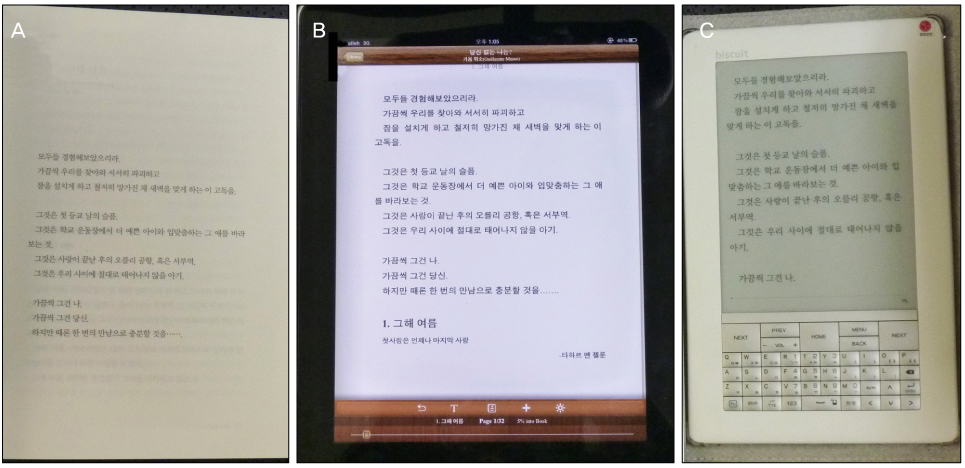J Korean Ophthalmol Soc.
2012 May;53(5):689-693.
Research on Ocular Fatigability Induced by Multimedia and Instrument Features
- Affiliations
-
- 1Department of Ophthalmology, Kim's Eye Hospital, Konyang University, Seoul, Korea. ungsookim@kimeye.com
Abstract
- PURPOSE
The aim of the present study was to evaluate the different features of such instruments and how they cause ocular fatigability.
METHODS
Under the same settings and circumstances, 75 participants were asked to read the novel, "You without me?" in different formats including paper book, E-book (biscuit(R), Interpark Inc., LG INNOTECK LTD, Korea) and LCD reader (iPad(R), Apple Inc., United States). For every 10 minutes of reading, 10 minutes of rest was provided. After finishing the novel, the participants were asked to complete a questionnaire, and the data obtained were statistically analyzed using univariate analysis.
RESULTS
Compared to paper book readers (1.93), LCD readers (2.40) complained of insufficient lubrication in the eye (p = 0.038), and experience more letter-floating illusions (1.92) than did paper book readers (1.49) (p = 0.043). Moreover, compared to the other formats including the E-book (20%) and paper book (8%), LCD readers (72%) experienced more significant glare symptoms (n = 23) and could read at a faster rate than the other groups of readers (n = 26).
CONCLUSIONS
In the present study, the I-Pad caused ocular fatigability more easily than the other formats examined. No statistical significance of ocular discomfort or fatigability was observed among the different format groups. Further investigation with a greater number of age-controlled participants should be conducted prior to designing a study to determine the best format for reading.
Keyword
Figure
Reference
-
1. Scheiman M. Accommodative and binocular vision disorders associated with video display terminals: diagnosis and management issues. J Am Optom Assoc. 1996. 67:531–539.2. Thomson WD. Eye problems and visual display terminals--the facts and the fallacies. Ophthalmic Physiol Opt. 1998. 18:111–119.3. Schlote T, Kadner G, Freudenthaler N. Marked reduction and distinct patterns of eye blinking in patients with moderately dry eyes during video display terminal use. Graefes Arch Clin Exp Ophthalmol. 2004. 242:306–312.4. Frank JH. The Preocular Tear Film in Health, Disease and Contact Lens Wear. 1986. Lubbock: Dry Eye Institute Inc.;32–38.5. McMonnies CW, Ho A. Patient history in screening for dry eye conditions. J Am Optom Assoc. 1987. 58:296–301.6. McMonnies C. Responses to a dry eye questionnaire from a normal population. J Am Optom Assoc. 1987. 58:588–589.7. 2008 Global Student E-book Survey. Ebrary®. c2008. Palo Alto, USA: Available from: http://site.ebrary.com/lib/librarycenter/docDetail.action?docID=80000726.8. Su SB, Lu CW, Sheen JW, et al. Tear secretion dysfunction among women workers engaged in light-on tests in the TFT-LCD industry. BMC Public Health. 2006. 6:303.
- Full Text Links
- Actions
-
Cited
- CITED
-
- Close
- Share
- Similar articles
-
- Development of Interactive Multimedia Learning in Aging Education
- Succinylcholine Induced-Ocular Position under the General Anesthesia
- Development and Evaluation of a Computerized Multimedia Approach to Educate Older Adults about Safe Medication
- Development of the Health-Information System using a Multimedia Tool
- Design of Collaborative Telemedicine Application System on Integrated Multimedia DooRae Framework


